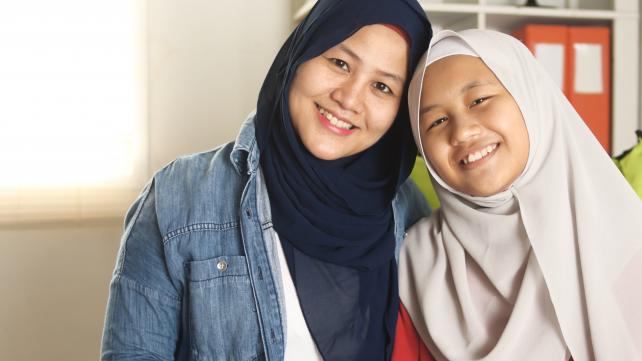
(Note: This article is part 2 of 2 in a series on Emotional Intelligence. You can read part 1 here.)
Last week, I sat down with Ruba Qasem, Licensed Associate Counselor, to gain a better understanding of what Emotional Intelligence is and why it’s so important for our families. In that first article, we explored five relevant factors - self-awareness, motivation to express emotions, regulation, social skills, and empathy - and how these skills benefit children now and into the future.
The big question that pops up for many after a discussion like that is: what can we do as parents to help our children? Read on to learn more about nurturing your child’s Emotional Intelligence.
MB: What can we (parents) do to model Emotional Intelligence for our children?
RQ: Modeling takes time.
The first step is to get in tune with your own emotions so that you can teach your children. Ask yourself: Are you expressing all of your emotions? Are you validating all of your emotions? Are you allowing yourself to show a range of emotions?
Children cannot do what they don’t see. You cannot teach it to your children if you aren’t also doing it at home. Whatever age you are, you have to pause and tell yourself to model it. It's never too late for you to start and it's never too late to learn.
It’s easier said than done, though. Sometimes it can be really hard and you’re going to make mistakes. At the moment, it can even be triggering. Triggers are repeat scenarios where adults are uncomfortable because of a past incident. It's important to identify your triggers and work through them.
Emotional Intelligence is knowledge and application, just like Islam.
Many parents want their children to be happy all the time. They assume that's the best and dismiss other emotions in the process. In our minds, we grew up learning that sad is bad, mad is bad, and that happiness is the only "good" emotion. But it's essential to validate all of the child’s emotions. Then you can set boundaries for certain kinds of behaviors and show them a better way to cope.
MB: Let’s talk about the difference between helping our children cope and shutting them down emotionally. Can you give me some examples to distinguish the two?
RQ: You have to connect with your child. You have to get down on their level and try to understand what it is they’re going through and what they need. Shutting a child down happens when we assume that we are more knowledgeable about their feelings and experience than they are. Don't assume that just because you're gentle and hugging them that you are validating them.
Helping a child cope sounds like: ASKING how they are feeling.
Shutting them down would be: TELLING them how they feel.
Helping them cope sounds like: VALIDATING their feelings.
Shutting them down would be: DENYING their feelings by telling them they don’t really feel that way or that they aren’t allowed to feel a certain way. “Don’t be sad” or “You’re fine” are good examples.
Helping them cope looks like: MAKING EYE CONTACT and getting down on their physical level to speak to them.
Shutting them down looks like: TALKING DOWN TO THEM or at them and not really giving them your attention.
Along with all of this, it’s important to acknowledge and validate their positive feelings, too. This helps make it easier for them to cope with negative emotions when they come.
MB: What are some practical things we can do to help our children cope with big emotions?
RQ: All families are unique, but Step 1 is to connect with your child. Learn how to talk to your child, play with them, know what they like to do and what helps them.
Something else that I think all families can also do with minimal prep, expense, or space is to provide a Calming Corner. Parents can even use the space themselves when they need it.
A Calming Corner is a physical space. It can be the corner of a room, it can be a tent, it can be a couch, a wall, any space to acknowledge that emotions are valued. It’s kind of like decor. If someone has a cute pumpkin and they’re never going to cook it, they can leave it out and have a Fall vibe in their house. This space is a physical acknowledgment of emotions being welcomed in the home. And now, when your child needs space to take a break or when they need to regulate, they have a space where they can go.
It really sets the mood in your home. Even when it’s not being used, the fact you have that space tells your family that all emotions are welcome. You can cater it based on your family’s needs. For some, it may mean time alone. For others, it may mean a shared space to decompress and reflect while you work through some practical coping techniques.
Some items that can be included in the calming corner based on your child’s needs are:
- Age-appropriate books about emotions and self-regulation
- For visual children, a sensory item that allows for movement outside of their bodies, like a sensory bottle or sensory wand
- For tactile children, you can have something that's physically regulating like a stress ball, a squeezy toy, or an ice cube
- For auditory children, something they can listen to, like Qur’an or simple Islamic songs
- And of course, you can always learn and include breathing exercises. The library has many options for books with breathing techniques for children.
The goal is to give them items that help them regulate with something they can control that is outside of their bodies.
It’s very important to understand that the Calming Corner is not a time-out station or a forced punishment. This is an optional, welcoming space for anyone who feels they need to regulate their emotions. When you leave it as an option, you give the control to your child which helps them to validate and regulate themselves so they can grow to become emotionally intelligent people. The more exposed they are to their emotions and to the space, the more they will learn to self-regulate.
When the situation has de-escalated you can move to Step 2, which is to have a conversation. Acknowledge your child, validate their emotions and let them cope.
This doesn’t mean that you can’t have rules or guidelines. You are still the parent and you are responsible for your children. There needs to be a balance between structure and flexibility. All emotions are valid, but sometimes certain actions are not okay and can become problems. It’s okay to be angry but hurting others or banging against the wall is not okay.
So, once the situation is de-escalated, that’s the time to set boundaries, talk about natural consequences, and show them better ways to cope. If they were angry for example, you can say, “it’s okay to feel angry but it's not okay to throw toys at your brother’s head.”
MB: Last one: what are some signs that it may be time for parents to reach out for professional help in this area?
RQ: Every family is different. Some big signs are:
- If the adults have unmanageable conflict or chaos, abuse, or mental illness, then they likely won't be equipped to help the children and need to seek outside help for them. Ideally, they should also seek help for themselves - a professional who is an unbiased, third party, outside of the home.
- Minus conflicts, abuse, or mental illness in the home, if the emotions or actions are outside of the parent’s capability where the child is showing behavior that is outside of the average norm, it’s also good to see a professional for help.
- Any kind of major life changes - moves, grief, divorce, etc.
Ideally, parents should also seek help for themselves when they need it - a professional who is an unbiased, third party outside of the home. If you’re living in an unhappy home or an unhappy marriage, no matter how much you do, there will be a gap in the emotional intelligence area so you need to seek help if you want your children to thrive.
For more information on nurturing emotional intelligence in your child, try:
- https://www.ahaparenting.com/guide/emotionally-intelligent-child
- https://biglifejournal.com/products/emotional-intelligence-kit
- https://www.soundvision.com/article/book-review-ruby-finds-a-worry
Melissa Barreto is a home educating mother of five children. She is the Co-Founder of Wildflower Homeschool Collective LLC, a homeschool organization based in Northern New Jersey.




Add new comment